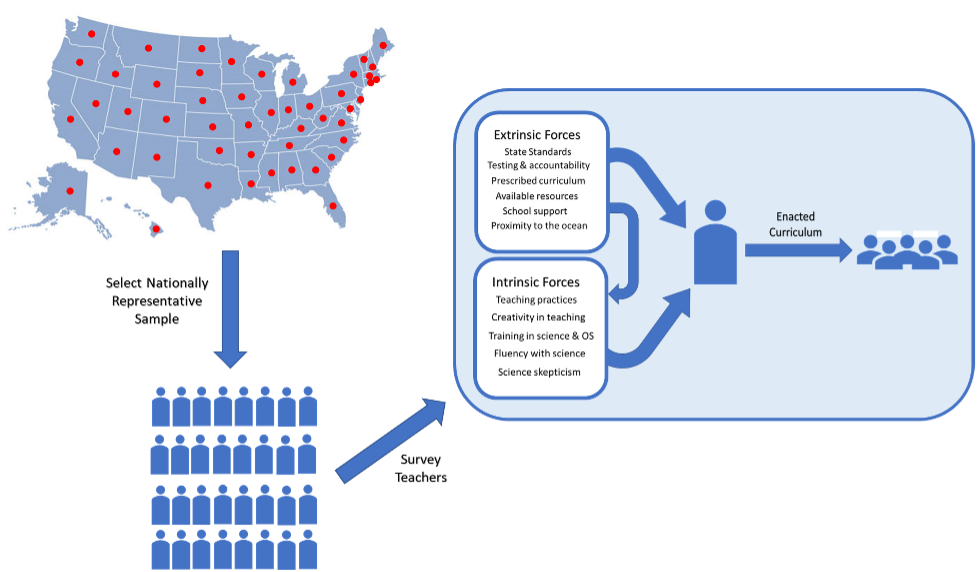Multidisciplinary Research Project - MARINE: Mapping Attitudes and Resources in Ocean Science Education Study
ECR Project Leaders:
Ella Claire Walsh
PI Project Leader:
Laura O’Dwyer
Research Project Description
The C-CoMP K-12 research group, which is made up of oceanography, microbiology and educational research experts, has embarked on a large-scale study (MARINE) to survey teachers from a nationally representative sample of middle and high schools (Fig. 1). The goal is to understand the forces, both extrinsic and intrinsic to teachers and classrooms, that influence their ability and desire to cover ocean science concepts in their classrooms.
An Ocean Literate Society
An ocean literate society is fostered through education and outreach that develops an understanding of the essential principles of ocean functioning, the ability to communicate about the ocean in a meaningful way, and the capability to make informed decisions regarding the ocean and its resources. The greatest opportunity for reaching the next generation in the U.S. begins in K-12 classrooms. Yet teachers in elementary, middle and high school rarely cover ocean science in their curriculum. Previous ocean literacy initiatives have recognized this practical gap in instruction and created comprehensive, low-cost resources targeting all grade ranges. However, these resources are often underutilized in schools. The C-CoMP K-12 research team aims to understand why topics related to the ocean are not prioritized in the classroom.
An Ocean Science Landscape Study
The limited research conducted in this area suggests that teachers in the U.S. face several constraints for incorporating novel topics into their curriculum, including the need to adhere to national and state standards and an already crowded curriculum to meet accountability requirements (Gillan, 2011; Stock, 2010). Moreover, teachers’ often weak preparation in ocean science leaves them feeling unprepared to cover ocean science concepts (Freitas et al., 2022). These barriers, and others not yet recognized, have stymied teachers’ opportunities to incorporate ocean science into their classrooms. To date, no large-scale representative sample of teachers has been asked about the reasons for the minimal coverage of ocean science in U.S. schools. Such a study would be capable of influencing policy decisions related to curriculum and teaching practices.
The C-CoMP K-12 research team has drawn two nationally representative samples of schools from sampling frames comprising 40,242 middle schools and 26,899 high schools. From these sampled schools, approximately 3,000 teachers have been invited to complete a survey about their coverage of topics related to the ocean in their classrooms. By surveying teachers from these nationally representative samples of schools, the team will develop a deep understanding of the reasons that ocean science is not covered extensively in U.S. classrooms. This study will provide key information for the changes needed to support more widespread integration of ocean science into K-12 education. Moreover, this study will provide baseline information against which future trends can be compared.
If we are to cultivate an ocean literate society capable of making informed and responsible decisions regarding the ocean and its resources, changes in K-12 classrooms are necessary. This study will provide credible evidence for how we proceed to make those changes.

References
Freitas, C., Bellrove, A., Venzo, P., & Francis, P. 2022. Towards a 2025 national ocean literacy strategy: current status and future needs in primary education. Frontiers in Marine Science 9:883524. https://doi.org/10.3389/fmars.2022.883524.
Gillan, A. 2011. Impetus and barriers to teaching ocean literacy: A perspective from landlocked middle school science teachers (Publication No. AAI3479485) [Doctoral dissertation, Purdue University]. ProQuest Dissertations.
Stock, J. 2010. Identifying obstacles to incorporating ocean content into California secondary classrooms [Master’s thesis, Dominican University of California]. Graduate Master’s Theses, Capstones, and Culminating Projects. https://doi.org/10.33015/dominican.edu/2010.edu.01.
